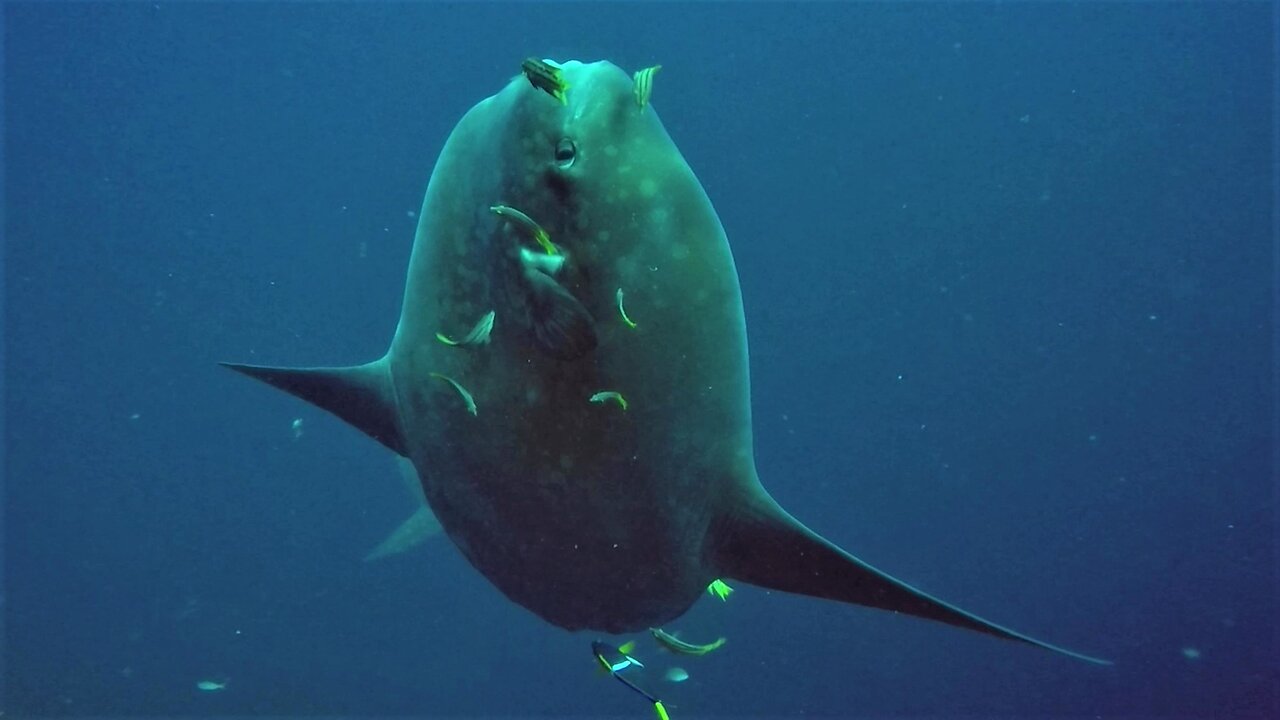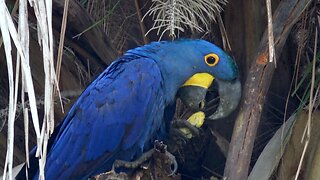Premium Only Content

Researchers sneak up on bizarre & reclusive giant Mola Mola fish
Researchers gathering underwater footage and data in the Galapagos Islands found what appears to be a Mola Mola cleaning station. These bizarre and mysterious fish grow to an incredible weight of nearly 2,270kg (5,000lbs). They are the largest of the bony fish anywhere on the planet. Often described as the animals that evolution forgot, or the fish that nature forgot, they look like a clumsy, prehistoric beast that consists of only a head and fins.
Descended from pufferfish, they have a tail that has evolved into a smaller, less obvious structure. They swim using their enlarged pectoral and ventral fins, in an unusual flapping motion. As expected, they are not fast swimmers. Although they can reach surprising speeds for very short distances, they generally swim at about 3.5km/h (2mph). When alarmed or threatened, the Moila Mola will often dive and accelerate, trying to reach depths at which their pursuers are not able to follow. They have little other ability to defend themselves.
Mola Mola are frequently referred to as ocean sunfish, due to their flattened shape. But common sunfish are unrelated to the Mola Mola and the similarity is in name and shape only.
These ocean giants swim with their mouth open at all times. They are actually incapable of closing their mouths. Originally thought to feed only on jellyfish, it is now understood that Mola Mola feed on small fish, fish larvae, squid, and crustaceans. Jellyfish comprise only 15% of their diet.
Mola Mola lay more eggs than any other vertebrate. They are capable of producing up to 300 million eggs at one time. They start out as larvae and tiny "fry" and then grow quickly, reaching a weight that is approximately 60 million times their birth weight. They will do this in a span of up to ten years. This believed to be one of the fastest growth rates of any known vertebrate animals. Their extreme growth rate and the implications that this could have for science and research are currently being studied.
These researchers have made their way along a wall where Mola Mola have been sighted previously. Carefully remaining partially concealed by the rocks, they peek out at this giant fish and record it as it suspends itself in a vertical position. This is an intentional signal to the wrasses in the area that the Mola Mola wants them to clean it, removing small parasites and dead skin. This helps the Mola Mola remain healthy and the wrasses receive a meal in return.
It's an example of a mutually beneficial, or symbiotic relationship. The researchers are recording this behaviour in what is a relatively rare opportunity to get so close to such an easily spooked animal. Tracking devices are also being installed on the fish to get a better idea of what their migration habits are. It is hoped that, as we learn more about these ocean giants, we will also gain a better understanding of how to conserve them.
-
 2:11
2:11
WildCreatures
4 days ago $1.16 earnedBrilliant Blue Hyacinth Macaw Eats Nuts With Impressive Dexterity
15.9K10 -
 17:51
17:51
TheRoyaltyAutoService
15 hours ago $0.17 earnedIs Flat Rate Ruining The Auto Repair Industry?!
2.36K4 -
 LIVE
LIVE
BEK TV
22 hours agoTrent Loos in the Morning - 8/28/2025
261 watching -
 LIVE
LIVE
The Bubba Army
21 hours agoMinneapolis Shooter Story Unfolds! - Bubba the Love Sponge® Show | 8/28/25
4,018 watching -
 26:00
26:00
DeVory Darkins
1 day ago $11.62 earnedDemocrat Mayor HUMILIATES himself during painful interview as Trump makes SHOCKING Announcement
35.4K85 -
 22:14
22:14
Ohio State Football and Recruiting at Buckeye Huddle
1 day agoOhio State Football: Everything Steve Sarkisian Said About the Buckeyes This Week
19K -
 1:19:55
1:19:55
TruthStream with Joe and Scott
1 day agoLisa, Michelle and Carole join Joe for Healing and Inspiration. Next healing will be on Aug 28th at Noon and 4pm eastern https://www.balancingbodyandsoul.com/?ref=TRUTHSTREAMSHOW
12.1K1 -
 10:32
10:32
Nikko Ortiz
16 hours agoFunniest Fails Of The Month
36.9K4 -
 28:59
28:59
The Jack Brewer Show
13 hours agoThe Jack Brewer Show S1 EP5 Charles Duke Tanner on Redemption, Fatherhood & Second Chances #podcast
6.37K -
 15:33
15:33
Bearing
23 hours agoSEPTUM RING THEORY 💥 Are Nose Ring Girls ALL INSANE LIBERALS?! 💀🤣
12K56